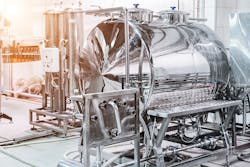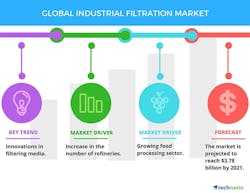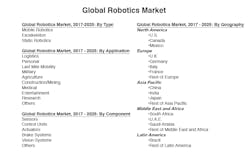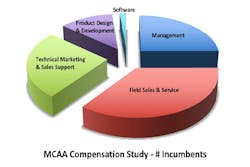Markets Update: Top trends boosting industrial filtration; Global level sensor market worth $5.48B by 2025
Industrial filtration market report forecasts trends through 2021
The top three emerging trends driving the global industrial filtration market are innovations in filtering media, growth in India’s chemical sector and Asia’s growing pharmaceutical sector, according to a new report from Technavio.
Technavio’s latest report on the global industrial filtration market provides an analysis of the most important trends expected to impact the market outlook from 2017 to 2021. The food and beverage sector requires special filter media to meet specific requirements and the high standards mandated by government regulations. Therefore, wastewater treatment, chemicals, filtration of drinking water and filtration procedures in crude oil processing are the key drivers of the growth of the industrial liquid filtration market.
India’s petrochemical and chemical industry is witnessing significant growth owing to increased demand from the manufacturing, process and agricultural sectors. India is the seventh-largest producer of chemicals and the third-largest producer in Asia. The uptick in the chemical sector in India is mainly attributed to the 100 percent FDI allowed by the government to encourage the industry.
India and China are the key emerging economies that are witnessing significant investments in various industrial sectors. The pharmaceutical industry in these countries is expected to grow during the forecast period due to various initiatives taken by the government to boost the sector. Air filters play a critical role during the manufacturing of drugs and other related products.
Image courtesy of Technavio
Global level sensor market size worth $5.48B by 2025
The global level sensor market is anticipated to reach $5.48 billion by 2025, according to a new report by Grand View Research Inc. Growing advancements in computer technology, coupled with stringent regulations for improved food quality and safety, have resulted in the rising need to automate manufacturing processes, thereby leading to an increased demand for level sensors in the food processing industry. Product design must comply with industry guidelines issued by the U.S. Food and Drug Administration (FDA). Programmable measuring instruments and specialized accessories are likely to drive the market demand over the forecast period.
Micro-Electro-Mechanical Systems (MEMS), a part of non-contact type sensors, is expected to witness considerable growth over the projected period. MEMS sensors are expected to play a key role in the automotive safety and infotainment applications. The need for higher accuracy, rapid data transmission, and self-test capabilities are the key factors driving the demand for MEMS in automotive applications.
The growing development of nanotechnology sensors is likely to influence the market growth over the forecast period as well. The non-contact type technology is anticipated to witness significant growth with a compound annual growth rate (CAGR) of more than 7.1 percent during the projected period.
The North American market was anticipated to dominate the level sensor in terms of revenue last year. The prevailing large existing consumer base and government initiatives to control carbon emissions are the key factors driving the North American regional growth. Asia-Pacific is expected to portray the highest growth over the forecast period because it is the major hub for refineries and chemical and petrochemical processing units.
Source: Grand View Research Inc.
North America leads worldwide robotics market
North America occupies the leading position in the global robotics market among other key regional segments, according to a report by Transparency Market Research (TMR).
In the global robotics market, dominating companies are hard-focused to utilize their technical and business strength for product innovation and for commercialization of these products to serve the industrial and service sectors that are brimming with opportunities, TMR reports. Leading companies include Fanuc Corporation, iRobot Corporation, Northrop Grumman Corporation and Google Inc., among others.
TMR’s research shows the global robotics market is likely to collect a revenue valuation of $147.26 billion by 2025 at a CAGR of 17.4 percent for the forecast period from 2017 to 2025. The market attracted a revenue of $35.23 billion in 2016. In regard to volume, the global robotics market stood at 677.2 thousand units in 2016 and is predicted to amount to 2,731.2 thousand units by 2025 rising at a CAGR of 17 percent between 2017 and 2025.
Static-type robots lead among other type segments because they are widely deployed across various industries such as manufacturing, aerospace and automotive.
Report predicts growth for 5 industrial categories in 2018
ITR Economics prepared a report exclusively for Measurement, Control & Automation Association (MCAA) members that reviewed five manufacturing categories: chemical and chemical products; food; paper and paper products; mining and electric power. ITR predicts growth for chemical production during 2018, as well as for paper production for a short period. While the report expects categories of food and mining production to grow in slower rates in 2018, a faster growth rate is foreseen for the recovering manufacturing sector based off a 0.7 percent increase year-over-year and the growth contributing to U.S. industrial production, which was up 0.5 percent. However, U.S. electric and gas utilities production is slowing, up 0.7 percent year-over-year and is expected to contract mildly during the next two quarters. U.S. electric power generation, transmission and distribution is expected to transition to a rise by early 2018.
Image courtesy of MCAA
MCAA publishes 2017 compensation report
A report published by the MCAA looks at industry compensation trends and discusses the impact retiring baby boomers and their young successors will have on high-tech based industries. It takes 18 to 36 months to fully train and transition young professionals into their respective industries, including getting accustomed with products and best practices, the report states.
In this year’s MCAA Compensation Report, there appeared to be a downward shift in base salaries with continuation of incentive or bonus payments in virtually every position. Comments from participants indicated wage freezes are still in effect based on the downturn in the market especially based on oil and gas prices. In a slight shift from prior years, more emphasis is being put on incentive compensation against performance goals than on base salary increases.
The Compensation Report is based on data contributed voluntarily by its member companies — both manufacturers and channel partners. Targeted at salaried positions, but including a wage rate report for both regular and temporary workers, the report covered these categories of personnel: general management, field sales and service, technical marketing and sales support, product design and development, and software.
MCAA represents the measurement, control and automation industry. The association provides community and resources for manufacturers and distributors of instrumentation and systems, used by global industries.



